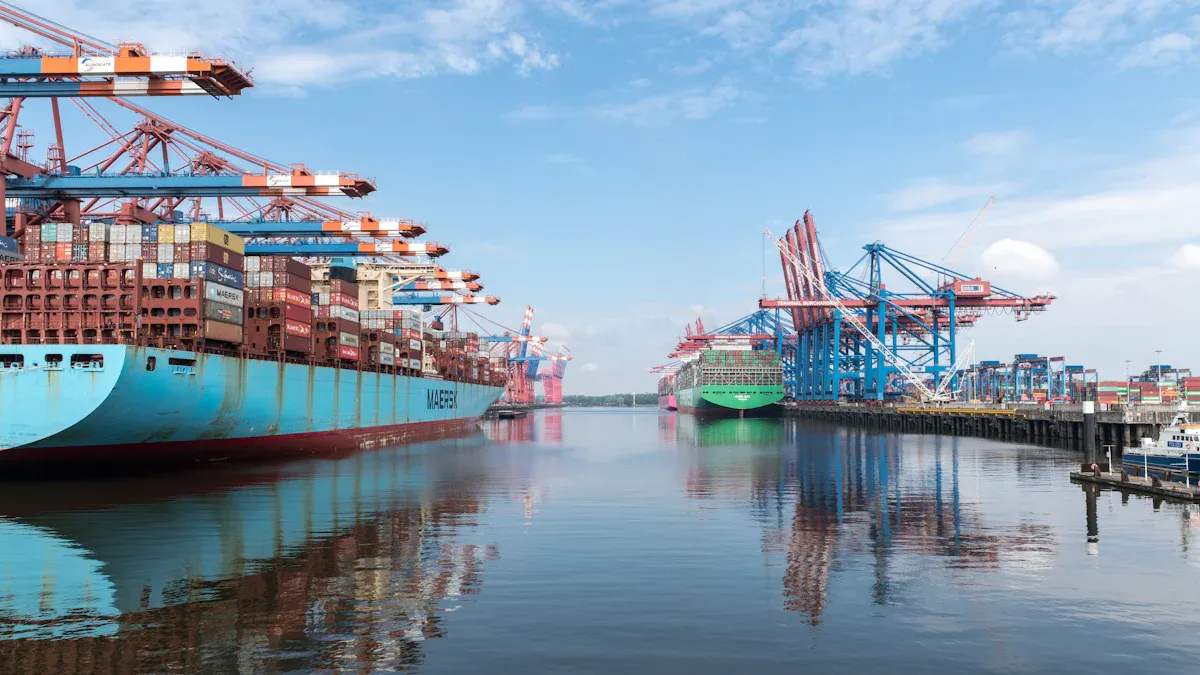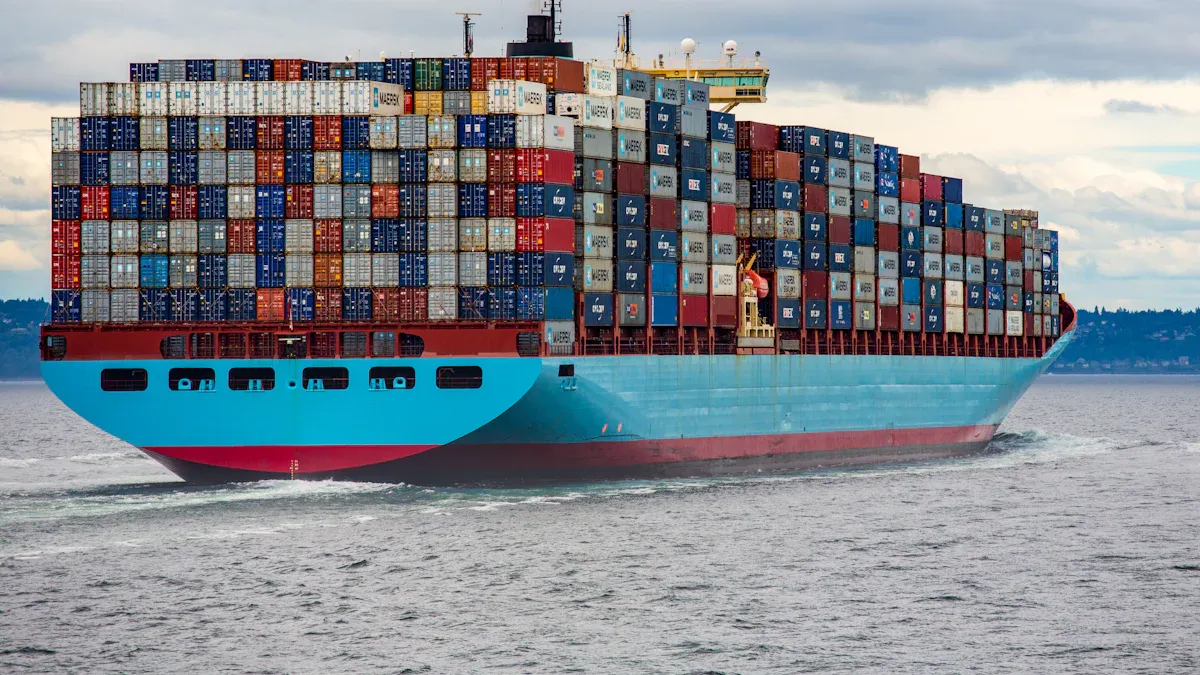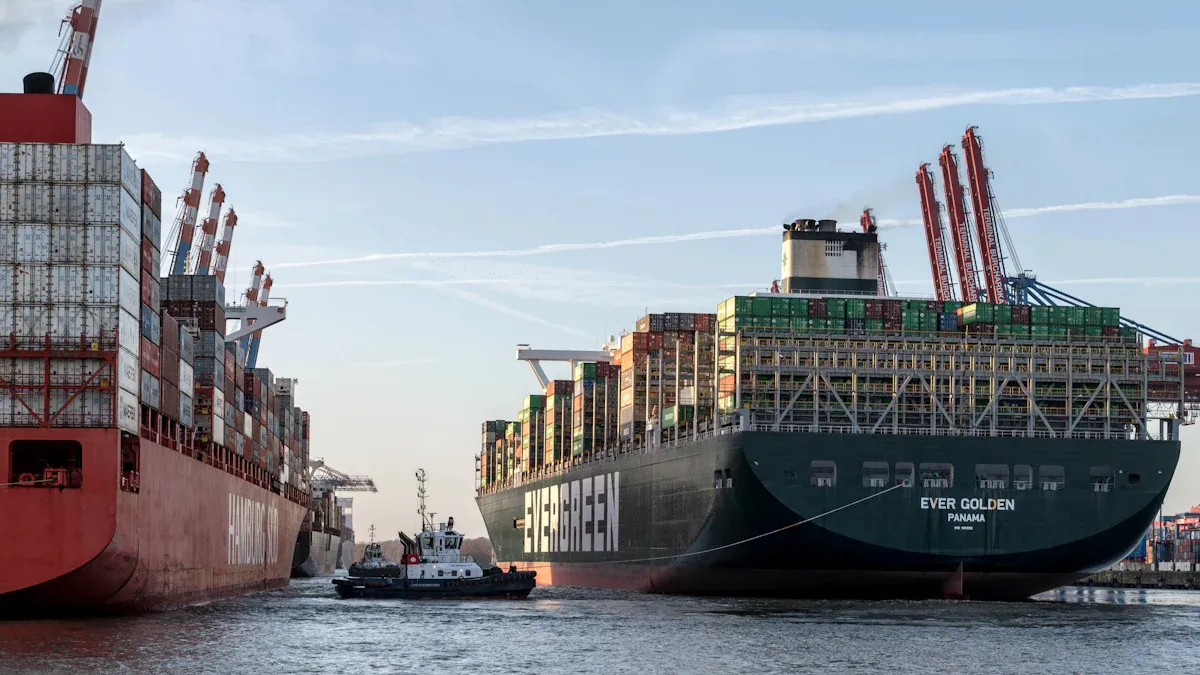A Complete Guide to Ocean Freight Shipping in 2025

Ocean freight shipping remains a cornerstone of international trade in 2025. You rely on it to move goods efficiently across continents, supporting global economies. However, challenges persist. Geopolitical tensions disrupt routes, raising costs. Port congestion causes delays, while rising fuel prices and labor costs impact carriers. These trends shape the future of ocean shipping.
Key Takeaways
Ocean freight shipping is the cheapest way to move lots of goods worldwide. It is very important for businesses in 2025.
Picking the right service, like Full Container Load (FCL) or Less than Container Load (LCL), helps save money and manage shipments better.
Planning early and using technology to track shipments live can make shipping smoother and avoid surprise costs.
Understanding Ocean Freight Shipping

What is ocean freight shipping?
Ocean freight shipping refers to the transportation of goods across international waters using container vessels. It plays a vital role in global trade, enabling the movement of large quantities of goods between countries. This method relies on designated sea lanes and is particularly suited for bulk shipments. Unlike air freight or courier services, which prioritize speed, ocean freight focuses on cost-efficiency. Smaller shipments or high-value products often use faster but more expensive alternatives. However, sea freight remains the most common transport method, accounting for 90% of goods shipped internationally. Its ability to handle massive volumes makes it indispensable for businesses engaged in cross-border trade.
Why ocean freight shipping is essential in 2025
In 2025, ocean freight continues to be a cornerstone of international freight shipping due to its cost-effectiveness and adaptability. For large shipments, it offers unmatched affordability, making it the preferred choice for businesses. The flexibility of sea freight allows companies to navigate geopolitical disruptions effectively. For instance, trans-shipment hubs enable goods to be rerouted efficiently, ensuring supply chains remain intact. Additionally, evolving trade patterns and sourcing strategies demand the use of ocean freight to meet market needs. Higher tariffs have also prompted importers and exporters to expedite production and shipping, further increasing the reliance on shipping by sea. The complexity of the carrier landscape in 2025 requires you to evaluate options carefully, considering factors beyond transit time and price. By leveraging sea freight, you can adapt to these challenges while maintaining cost efficiency.
Exploring Ocean Freight Services with JUSDA
Full Container Load (FCL) services
Full Container Load (FCL) services offer you exclusive use of an entire container for your shipment. This option is ideal when you need to transport large volumes of goods. FCL provides several advantages:
Shortened transit times, as your shipment moves directly to its destination without delays caused by consolidating or deconsolidating cargo.
Reduced risk of damage since your goods are handled less frequently and are not mixed with other shipments.
Easier tracking, allowing you to monitor your shipment's progress more efficiently.
Better suitability for perishable goods, ensuring they arrive before expiration.
By choosing FCL, you can streamline your logistics and ensure your cargo reaches its destination safely and on time.
Less than Container Load (LCL) services
Less than Container Load (LCL) services allow you to share container space with other shippers. This option is perfect for small and medium-sized enterprises (SMEs) or when you need to ship smaller quantities. LCL offers:
Flexibility in pickup and delivery schedules, enabling frequent shipments without requiring a full container.
Cost-effectiveness, as you only pay for the space your cargo occupies.
Lean inventory management, helping you avoid large storage spaces and maintain efficient logistics.
LCL shipping services empower you to manage costs effectively while maintaining a steady supply chain.
Roll-on/Roll-off (Ro-Ro) shipping
Roll-on/Roll-off (Ro-Ro) shipping is designed for wheeled cargo that can be driven onto and off the vessel. This method is commonly used for:
Automobiles and vehicles, including cars, trucks, and buses.
Heavy machinery like bulldozers and cranes.
Railroad cars when rail transport is unavailable.
Trailers and semi-trailers for quick loading and unloading.
Oversized cargo, such as wind turbine components.
Ro-Ro shipping ensures efficient handling of large, mobile, or oversized goods, making it a reliable choice for industries like automotive and construction.
Break Bulk cargo solutions
Break Bulk cargo solutions cater to goods that cannot fit into standard containers. These include project cargo, heavy lift items, and out-of-gauge cargo. Break bulk shipping involves loading individual or bundled pieces directly onto the vessel. This method is ideal for transporting large, high-value, or complex items that require special handling. By using break bulk solutions, you can move oversized or irregularly shaped goods efficiently, even when containerized shipping is not an option.
Reefer container services for temperature-sensitive goods
Reefer container services are essential for transporting temperature-sensitive goods. Industries such as food and beverage, pharmaceuticals, flowers, cosmetics, and chemicals rely on these containers to maintain product integrity. Reefer containers provide precise temperature control, ensuring your goods remain fresh and safe throughout the journey. Whether you need to ship frozen foods or delicate medical supplies, these containers offer a dependable solution for preserving quality.
The Ocean Freight Shipping Process

Booking and documentation requirements
Booking your ocean freight shipment requires careful preparation. You must provide essential documents to ensure a smooth process. These include:
Commercial Invoice: Details the goods, including value and quantity.
Packing List: Lists cargo inventory with weight and dimensions.
Bill of Lading (B/L): Serves as proof of ownership and a transport contract.
Certificate of Origin: Confirms the source of the goods.
Insurance Certificate: Verifies cargo insurance coverage.
Booking Confirmation: Confirms your space reservation.
Shipper’s Letter of Instruction (SLI): Provides specific handling and routing instructions.
Accurate documentation ensures compliance with customs and avoids delays in the ocean freight forwarding process.
Cargo pickup and container loading
The freight forwarding process begins with cargo pickup and container loading. Specialized equipment like cranes or forklifts handles containers. Follow these steps to prepare your cargo:
Protect fragile items with bubble wrap or packing peanuts.
Stack cargo vertically to maximize space while ensuring stability.
Secure items using straps, load bars, or bracing plywood.
Fill gaps with dunnage bags to prevent shifting during transit.
Distribute weight evenly to avoid tipping.
Proper loading ensures your goods remain safe throughout the ocean freight journey.
Customs clearance and port handling
Customs clearance and port handling are critical steps in the ocean freight forwarding process. Delays often occur due to incomplete customs declarations or unexpected duties. To avoid these issues, ensure all documents are accurate and complete. At the port, containers undergo inspection before being loaded onto vessels. Efficient customs handling minimizes disruptions and keeps your shipment on schedule.
Ocean transit and real-time tracking
During ocean transit, real-time tracking enhances the freight forwarding process. Tracking systems provide accurate information about your shipment’s location and estimated arrival time. This improves operational efficiency and reduces costs by avoiding detention fees. Real-time visibility also boosts customer satisfaction by enabling proactive communication and timely updates.
Delivery and final clearance
The final stage of the ocean freight forwarding process involves delivery and clearance. After import customs clearance, your goods move to the destination warehouse. The steps include:
Import customs clearance with necessary paperwork and fees.
Destination handling to verify goods and prepare for delivery.
Final transportation to your designated location.
Efficient handling at this stage ensures your shipment reaches its destination without delays.
Freight Shipping Rates and Cost Factors
Key elements influencing freight shipping rates
Freight shipping rates in 2025 depend on several critical factors. Understanding these elements helps you plan your logistics budget effectively:
Geopolitical tensions and trade policies: Political events can disrupt shipping routes, leading to a 38% increase in costs.
Supply and demand imbalances: Oversupply in some regions lowers rates, while shortages in others drive them up.
Rising operational costs: Higher expenses for fuel, labor, and regulatory compliance affect shipping companies' profitability.
Port congestion and infrastructure challenges: Delays at ports add extra costs, impacting overall freight rates.
By monitoring these factors, you can anticipate changes in ocean freight costs and adjust your strategies accordingly.
How ocean freight rates are calculated in 2025
Ocean freight rates in 2025 are calculated using a combination of base charges and additional fees. Here's a breakdown of the key components:
Component | Description |
|---|---|
Base freight rate | The basic cost of shipping goods from the port of origin to the destination. |
Bunker Adjustment Factor (BAF) | A surcharge for fluctuations in fuel prices. |
Currency Adjustment Factor (CAF) | A surcharge for exchange rate fluctuations. |
Terminal Handling Charges (THC) | Fees for handling containers at ports. |
Surcharges | Additional fees for hazardous materials, peak season, or port congestion. |
You can calculate freight rates manually by considering these charges or use online freight calculators. These tools factor in cargo type, origin, destination, and any extra services you require.
Additional fees and surcharges to consider
When planning your ocean shipping, you should account for additional fees that may arise. These include:
General Rate Increase and Peak Season Surcharge for high-demand periods.
Emergency Bunker Surcharge and Fuel Adjustment Factor for fluctuating fuel costs.
Port Congestion Surcharge and Terminal Handling Charge for delays and port operations.
Container Imbalance Charge for repositioning empty containers.
Suez Canal Surcharge and Panama Canal Transit Fee for specific route usage.
These fees can significantly impact your freight shipping rates. By understanding them, you can better manage your shipping expenses and avoid unexpected costs.
Advantages and Challenges of Ocean Freight Shipping
Benefits of ocean freight shipping for businesses
Ocean freight shipping offers several advantages that make it a preferred choice for businesses in 2025. Its cost-effectiveness allows you to transport large volumes of goods at a fraction of the cost of air freight. This affordability is especially beneficial for industries dealing with bulk shipments like electronics, automotive, and FMCG. Ocean freight also provides enhanced flexibility. For example, strategic partnerships, such as MSC’s slot exchange with Premier Alliance, improve port coverage and shipping frequency, ensuring your goods reach their destination efficiently.
Predictable pricing is another key benefit. Index-linked contracts tie shipping rates to market trends, reducing administrative burdens and fostering long-term relationships with carriers. This predictability helps you plan your logistics budget more effectively. Additionally, advanced tracking tools enhance supply chain visibility, allowing you to monitor shipments in real time. By optimizing shipping schedules and diversifying supply chains, you can mitigate risks from geopolitical tensions and ensure smooth operations.
Common challenges and how to address them
Despite its benefits, ocean freight shipping comes with challenges. Natural disasters, such as hurricanes and floods, can disrupt transportation routes and damage infrastructure. Climate change further complicates logistics, leading to delays and increased costs. Geopolitical events and labor shortages also create uncertainty, affecting supply chains and operational efficiency. Security threats, including cyberattacks, pose risks to your freight shipping operations, while sudden demand fluctuations can strain shipping capacity.
To address these challenges, you can diversify port locations to reduce reliance on a single hub. Enhancing supply chain visibility with advanced tracking systems helps you anticipate and respond to potential disruptions. Partnering with experienced logistics providers, like JUSDA, ensures you have the expertise needed to navigate complex situations. These strategies enable you to overcome obstacles and maintain reliable ocean freight operations.
Comparing Ocean Freight with Other Modes of Transport
Ocean freight vs. air freight: Key differences
When deciding between ocean freight and air freight, you should consider several key differences. Ocean freight is more cost-effective, especially for large shipments. For example, shipping an 85 kg cargo costs around $400 by sea compared to $600 by air. Air freight, however, offers unmatched speed, delivering goods within days, while ocean freight can take weeks. This makes air freight ideal for time-sensitive shipments.
Ocean freight also has a better environmental impact. It produces fewer carbon emissions per ton of cargo compared to air freight, making it a greener choice. However, it comes with slower transit times and potential delays due to port congestion or weather conditions. Air freight, on the other hand, provides reliability and speed but at a significantly higher cost. For instance, a shipment costing $100 by sea could cost $1200 by air, especially for heavier cargo.
If you prioritize cost and sustainability, ocean freight is the better option. But if speed and reliability are critical, air freight may suit your needs better.
When to choose ocean freight over other options
You should choose ocean freight when cost efficiency and capacity are your top priorities. It is the best choice for bulk shipments, such as electronics, automotive parts, or FMCG products. Ocean freight allows you to transport large volumes at a fraction of the cost of air freight. It is also ideal for goods that are not time-sensitive, as the longer transit time is offset by significant savings.
Ocean freight is particularly advantageous for businesses aiming to reduce their carbon footprint. Its lower emissions make it a sustainable option for environmentally conscious companies. Additionally, ocean freight is suitable for oversized or heavy cargo that cannot be accommodated by air freight. By choosing ocean freight, you can optimize your logistics while keeping costs and environmental impact in check.
Optimizing Ocean Freight Shipping with JUSDA Warehousing Solutions
Leveraging JUSDA's warehouse network for efficient logistics
JUSDA's extensive warehouse network plays a vital role in optimizing ocean freight logistics. With facilities strategically located across regions like North America, Vietnam, and India, you can benefit from tailored solutions that meet local market demands. This localization strategy enhances response times and competitiveness, especially in high-value sectors like electronics and automotive.
JUSDA's advanced technologies, such as RFID and Warehouse Management Systems (WMS), improve inventory accuracy and operational efficiency. The JusLink Smart Supply Chain Management Platform provides end-to-end visibility, allowing you to track shipments and manage inventory seamlessly. Additionally, automation in warehousing reduces manual errors and accelerates processes, ensuring your goods are ready for ocean freight shipping on time.
Service Aspect | Contribution to Logistics |
|---|---|
VMI | Enhances inventory management and reduces stockouts. |
Cross-border logistics | Facilitates seamless international shipping and compliance. |
Warehousing | Provides storage solutions that optimize space and access. |
Distribution | Ensures timely delivery to end customers. |
Planning shipments in advance for cost savings
Planning your ocean freight shipments in advance can significantly reduce costs. By preparing all necessary documentation correctly, you avoid delays and additional expenses. Effective planning also helps you prioritize shipping requirements and build strong relationships with carriers and freight forwarders.
You can save money by avoiding urgent shipment designations and leveraging off-peak shipping days. For example, scheduling shipments during less busy periods can lead to lower rates. Considering backhaul shipping options, where carriers transport goods on return trips, can further reduce expenses. These strategies not only optimize your logistics but also ensure smoother operations.
Tip: Advance planning allows you to align your shipping schedule with your inventory needs, minimizing storage costs and improving supply chain efficiency.
Using technology for real-time tracking and efficiency
Technology enhances real-time tracking and efficiency in ocean freight shipping. IoT devices provide granular visibility into the condition and location of your goods, ensuring you stay informed throughout the journey. Real-time data availability allows you to make accurate decisions, such as optimizing vessel speed and fuel consumption.
Automated systems estimate arrival times and provide market information, helping you plan better. API integrations enable real-time retrieval of shipping rates and forecasts, streamlining your operations. Tools for tracking routes and berthing decisions improve transparency, ensuring your shipments reach their destination efficiently. By leveraging these technologies, you can enhance both operational efficiency and customer satisfaction.

JUSDA Solutions
To provide you with professional solutions and quotations.
Ocean freight remains vital in 2025, supporting global trade as companies diversify sourcing strategies. Markets in Southeast Asia, South Korea, and India are growing, reshaping import dynamics. To adapt, you should monitor policy changes, build inventory ahead of tariffs, and use diverse carriers to mitigate risks.
The future of ocean shipping looks promising, with the industry projected to grow to USD 89.9 million by 2028. JUSDA plays a key role in this evolution. Its global network and advanced digital solutions, like real-time tracking, enhance supply chain efficiency. By prioritizing sustainability, JUSDA aligns with the demand for greener logistics, ensuring you stay competitive in a dynamic market.
See Also
Discovering Innovations in Sea Freight Logistics for 2024
An In-Depth Look at Leading Global Logistics Firms
Comprehensive Insights on Eco-Friendly Transportation Solutions
A Detailed Exploration of LTL Freight's Future Trends
Get Prepared: Unveiling New Transport Tech for Supply Chains
